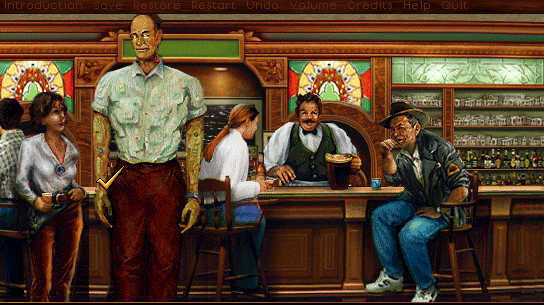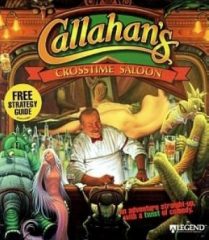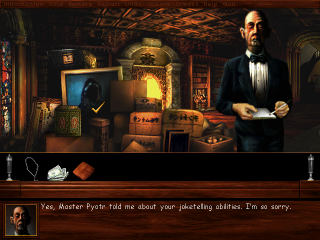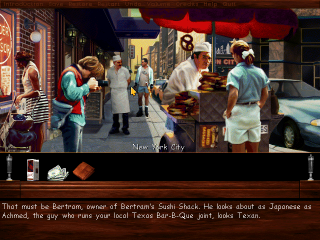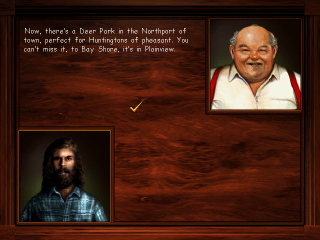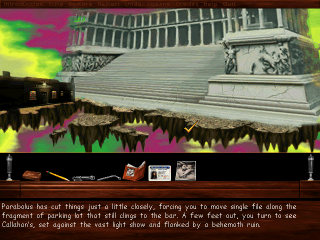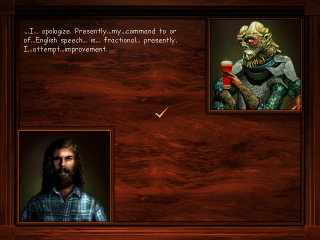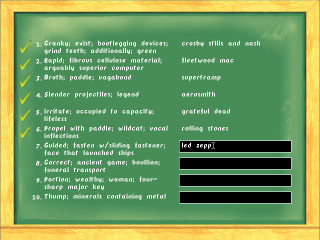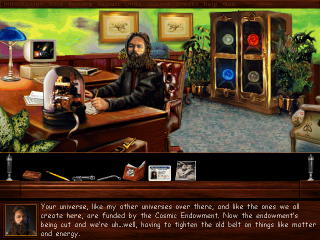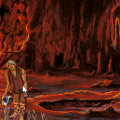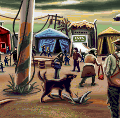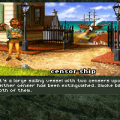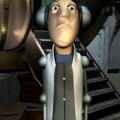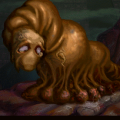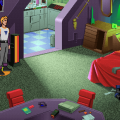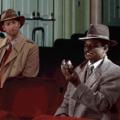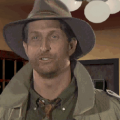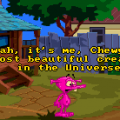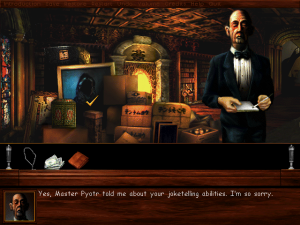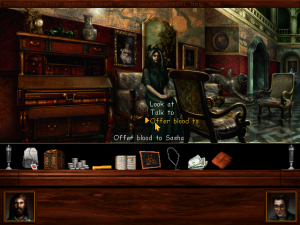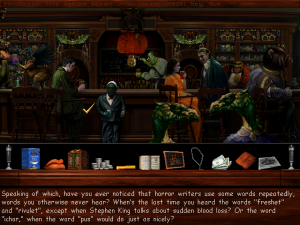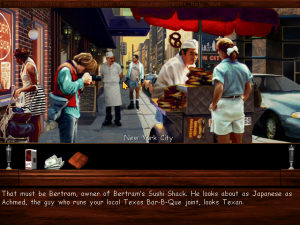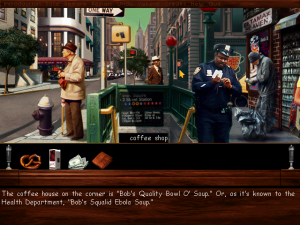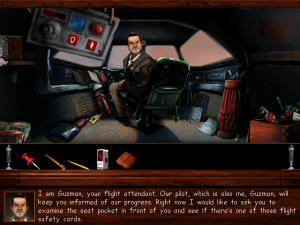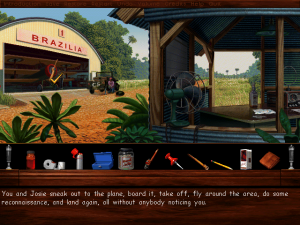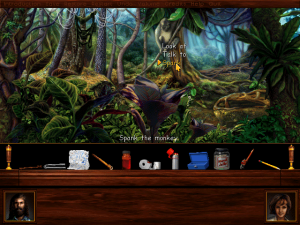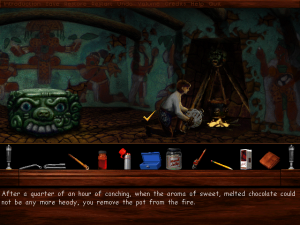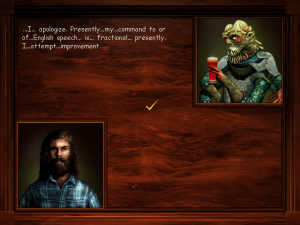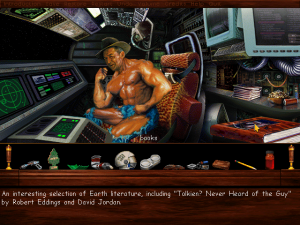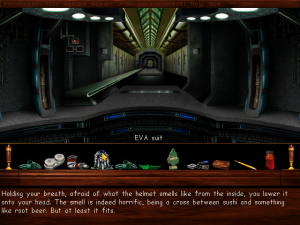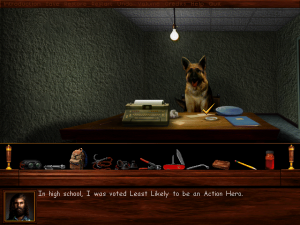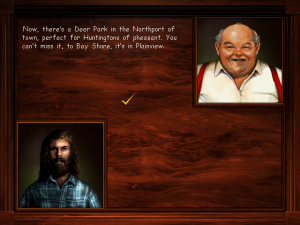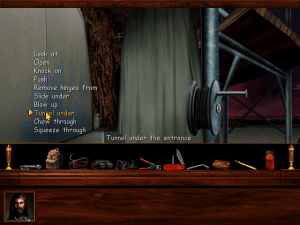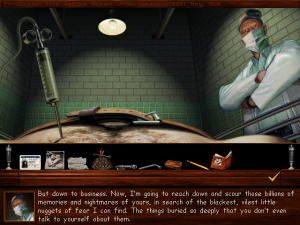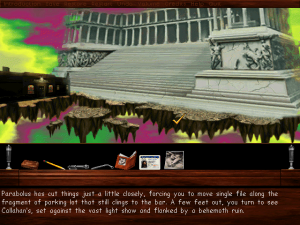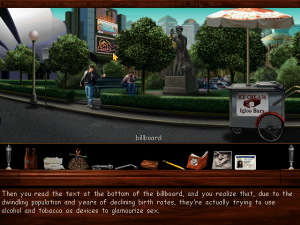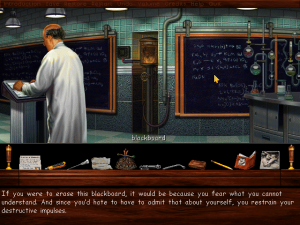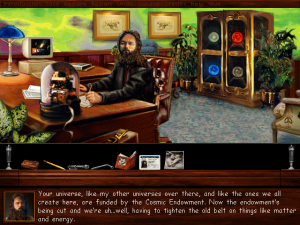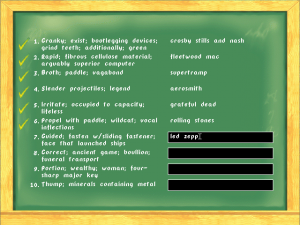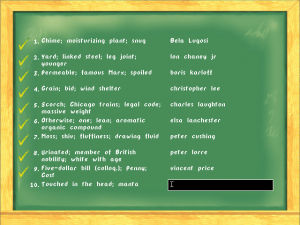Science fiction author Spider Robinson is the recipient of three Hugo awards, one Nebula, and the Robert A. Heinlein award for lifetime achievement. His most popular series started with Callahan’s Crosstime Saloon, which began as anthologies of short stories which soon spread out into full-size books, numbering nine in total. In the late ‘80s – the early days of the consumer internet – the Callahan fandom registered as one of the largest non-porn newsgroups, at least according to the flaps on Robinson’s more recent books. It’s a bit tragic then, that despite its previous popularity, much of his work has since gone out of print in the last decade.
Legend Entertainment often made its living on adventure games tied in with various literary licenses. Beginning with two text adventures based on Frederik Pohl’s Gateway novels, they produced entries on Piers Anthony’s Xanth series, Margaret Weis and Tracy Hickman’s Death Gate cycle, and Terry Brooks’ Shannara books. Callahan’s Crosstime Saloon, released in 1997, heralds the return of a science fiction license after a number of traditional fantasy based games, but Robinson’s books are a far cry from hard sci-fi. Rather, they combine fantastical elements with a good bit of comedy, and more than its share of drama.
Callahan’s Crosstime Saloon focuses on a bar in Long Island, but not any old bar. This particular bar is a gathering point for any number of beings, ranging from aliens to vampires to time travelers – and of course, humans. It’s a warm, friendly place that’s often compared to an intergalactic version of Cheers, a place where the regulars are more than happy to lend their ears to the troubles of anyone who’s willing to open up. This setting acts a device for a number of strange folk to join the crew and tell their own bizarre tales of pain, love and loss. The recurring theme throughout the novels (and the game, of course) is that the best way to deal with life’s tragedies is through laughter. As the first story of the first book puts it, “Callahan loses a lot of his regulars. After they’ve been coming around long enough, they find they don’t need to drink any more. It’s that kind of bar.”
Much like the initial trilogy of books, the Callahan computer game is set up as a series of short anthologies. As folk singer Jake Stonebender (and stand-in for Spider Robinson himself), you aid and explore the lives of five of the bar members, each with their own dilemma. Very little time is actually spent in the bar, which acts as a hub for all of the other adventures. The first three can be completed in order, and finishing those will open up the next two, before the (fairly short) final chapter.
In one chapter, the vampire Pyotr runs back to Transylvania to mourn the loss of his long time lover to another man. Jake must hitch a ride halfway across the world to make things right. Along the way he’ll infiltrate the ranks of the locals and discover a bar strangely parallel to Callahan’s, except it’s filled with monsters drawn from mythology and horror movies alike. In another chapter, the alien Squish has second thoughts about his race’s plan to bombard the Earth with a dose of testosterone inhibiting rays, so Jake and retired bomb squad cop Noah take a journey into outer space to stop it, all the while futzing with alien controls and futuristic thingamabobs. And another segment involves the time traveler Josie as she laments the extinction of a special plant in South America that can produce the most delicious chocolate in existence. The duo must first visit the offices of Faston Casteroga, an evil pencil conglomerate that’s bulldozing the rain forest, before visiting the jungle itself to make one final candy bar.
The fourth story revolves around the talking German Shepherd Ralph von Wau Wau, who has been captured by the government and is being experimented upon to learn his fantastic secrets. Jake must play the role of a super spy and sneak into a facility deep in the mountains. The fifth chapter involves the time traveling conman Al Phee, who has been cursed with uncontrollable psychic powers, coming from a future where everyone can read everyone else’s minds due to drug influence. Jake finds himself jumping to the future (not at all how William Gibson described it), joining a gang, and rising through the ranks to meet with a malicious doctor to find the cure. Once all are completed, a more pressing matter comes to light – the whole universe is about to be shut down due to budget cuts, but the compassion shown through your adventures acts as a justification for humanity’s continued existence. The final areas involve all of your friends visiting what is essentially the courthouse of the gods to argue your case.
This setup essentially mirrors the very first story of the very first book, where the inhabitants of Callahan’s convince an otherworldly being that Earth has a valid reason for existing (this alien, a tall gangly fellow named Mickey Finn, ends up joining the Callahan crew but only plays a small role in the game). Although the characters are all taken from the books, the scenarios themselves are entirely new. However, for those unfamiliar with the original stories, it can take a little while to get settled in. The “Look” command offers short descriptions of each of the major character, and the enclosed hint book gives sufficient backgrounds for all them, but going in cold feels like entering a community where everyone knows each other very well, and assumes that you do too. Once you’ve begun your first adventure and the stories become more focused, it’s much easier to acclimatize to Spider Robinson’s eccentric little world, but reading the books first is definitely recommended.
The interface is similar to other Legend games, although it eliminates the command bar on the side of the screen in favor of a completely contextualized menu system, which brings up all relevant commands when clicking on something. This frees up some screen real estate, which is especially important because each location is not merely a single screen, but rather one large panorama image. Although each chapter contains a small number of locations, rarely numbering more than half a dozen, each area is filled to the brim with hotspots, whether interactive or just there for flavor.
The depth of writing has always been Legend’s greatest strength, and this is where Callahan’s Crosstime Saloon excels. You can spend tons of time on a single screen, looking and prodding at everything, and many give different responses if you continuously muck with them. Most prompt commentary from Jake and whomever his sidekick is at the moment, but the best are the numerous tangents and jabs that come from investigating the most innocuous objects. Check out a random part of the bar and the game will start a rant about how certain words, like “rivulet” or “ichor” are only ever used in Stephen King novels. Investigate an innocuous box and the game will inform you that it’s been psychologically profiling you the entire time and dumps a text file in your directory with its analysis (it doesn’t seem to actually work though, appearing to be the same thing every time regardless of your actions). In keeping with Robinson’s books, there’s an unfortunate fondness for legions of puns, which manage to be both clever and (self consciously) painful. Although Robinson had nothing to do with the game beyond his authorization (and approval, as his introduction in the hint guide says), Sierra veteran Josh Mandel, the writer of Freddy Pharkas and Space Quest 6, does a damn fine job of capturing the spirit of the original stories, all while creating a world that’s so full of colorful details it’s possible to become distracted from the task at hand.
If there’s any problem with such richly detailed locations, it’s because of the total sensory overload. There’s so much to see and do in each possible screen – some of which even change slightly as you leave and reenter – that it’s hard to pick out what’s relevant to continue your quest. Amidst all the hotspots, sometimes just finding where the exits are can be difficult, and the quick travel arrows from the older Legend games are sorely missed. It also takes several seconds for the screens to transition, even on the fastest computers running DOSBox, making some of the puzzles a bit tedious, especially when you need to backtrack to pick up items that you missed. In spite of the occasional headache, it’s hard to really spite a game for being too detailed, especially when said detail is almost always amusing.
The puzzles, for the most part, aren’t too hard once you’ve figured out which items are important and which aren’t. The game opens with a pun-based word puzzle, as the denizens of Callahan’s subject you to a series of riddles. Here, the game provides a word from a phrase and you need to think of a synonym. When strung together, these synonyms form the sounds of an entirely different word, each with its own theme. At the beginning, you’re challenged to name various famous musicians. The first is: “Cranky; exist; bootlegging devices; grind teeth; additionally; green.” The answer? “cranky = cross”, “exist = be”, “bootlegging device = still”, “grind teeth = gnash”, “additionally = and” and “green = young”. Put together, that yields “cross be still gnash and young”, or “Crosby Stills Nash and Young”. There’s no doubt that for those who aren’t masters of the English language, these can be damn hard, especially considering this is the first puzzle of the game. Still, for this one, if you’re familiar enough with American music, you can piece together most of them by figuring out a small part of the puzzle. A later permutation of the same puzzle, based off movie monster actors, is a bit more obscure, and can potentially require a bit of research (or at least some time spent exploring Transylvania).
Some other puzzles require similar types of wordplay, or at least a bit of outside knowledge, enough for you to piece together that, say, the phrase “CIVIC MILL MILD DILL MIX” looks awfully like a series of roman numerals. There are a few other puzzles that might cause hiccups, but for the most part they aren’t too bad. There’s one involving placing small stones in various formations, although there’s an in-game option to cheat past it totally. And there’s a maze section where you crawl through a series of vents and disable their fans.
Graphically, it’s easily the best looking of Legend’s adventures, with visuals just as detailed as the writing, and a realistic appearance that still maintains its own artistic stylings. Since the Callahan novels were never adapted to any other medium, this is the only graphical representation of Robinson’s world outside of the book covers, and it looks fantastic. The animation is sparse, but there’s enough to make it seem lively despite the fact that the characters never actually move. The voice acting, as with Legend’s other games, is impeccable, with each character being brought to life through their own unique mannerisms and accents. The music lies mostly in the background when it’s present, and most scenes are accompanied by atmospheric effects, although there are a number of songs sung by Spider Robinson himself. As his introduction in the hint book states, he originally wanted to be a folk singer, and this game gave him the opportunity to make up some recordings. They’re only played on request at the bar, or during the credit sequences, but they’re all quite catchy and usually pretty funny too.
There’s little to actively criticize about Callahan’s Crosstime Saloon – like the books, it’s rich, funny, and even a bit heart-warming without being schmaltzy. Despite its largely light hearted tone, it’s not afraid to get serious, as in the section where Jake recounts his own tragic backstory involving his departed wife and daughter. Fans of the books will find more tales beyond Robinson’s work, and newcomers will perhaps find themselves as converted fans to a series that deserves more popularity.
